The Differential Effects of Augmented Reality and Product Presentation Strategies on Brand Recall: An Embodied Cognition Perspective
Abstract
1. Introduction
2. Theoretical Background
2.1. Augmented Reality and Brand Management
2.2. Brand Recall
2.3. Embodied Cognition Theory
3. Hypotheses
3.1. Augmented Reality and Brand Recall
3.2. The Moderating Effect of Product Presentation Strategies
4. Empirical Studies
4.1. Study 1
4.1.1. Participants and Design
4.1.2. Measures
4.1.3. Materials and Procedure
4.1.4. Results
4.2. Study 2
4.2.1. Participants and Design
4.2.2. Materials and Procedure
4.2.3. Results
5. General Discussion
5.1. Research Finding
5.2. Theoretical Contribution
5.3. Practical Contribution
5.4. Limitations and Future Research
Author Contributions
Funding
Institutional Review Board Statement
Informed Consent Statement
Data Availability Statement
Conflicts of Interest
Appendix A
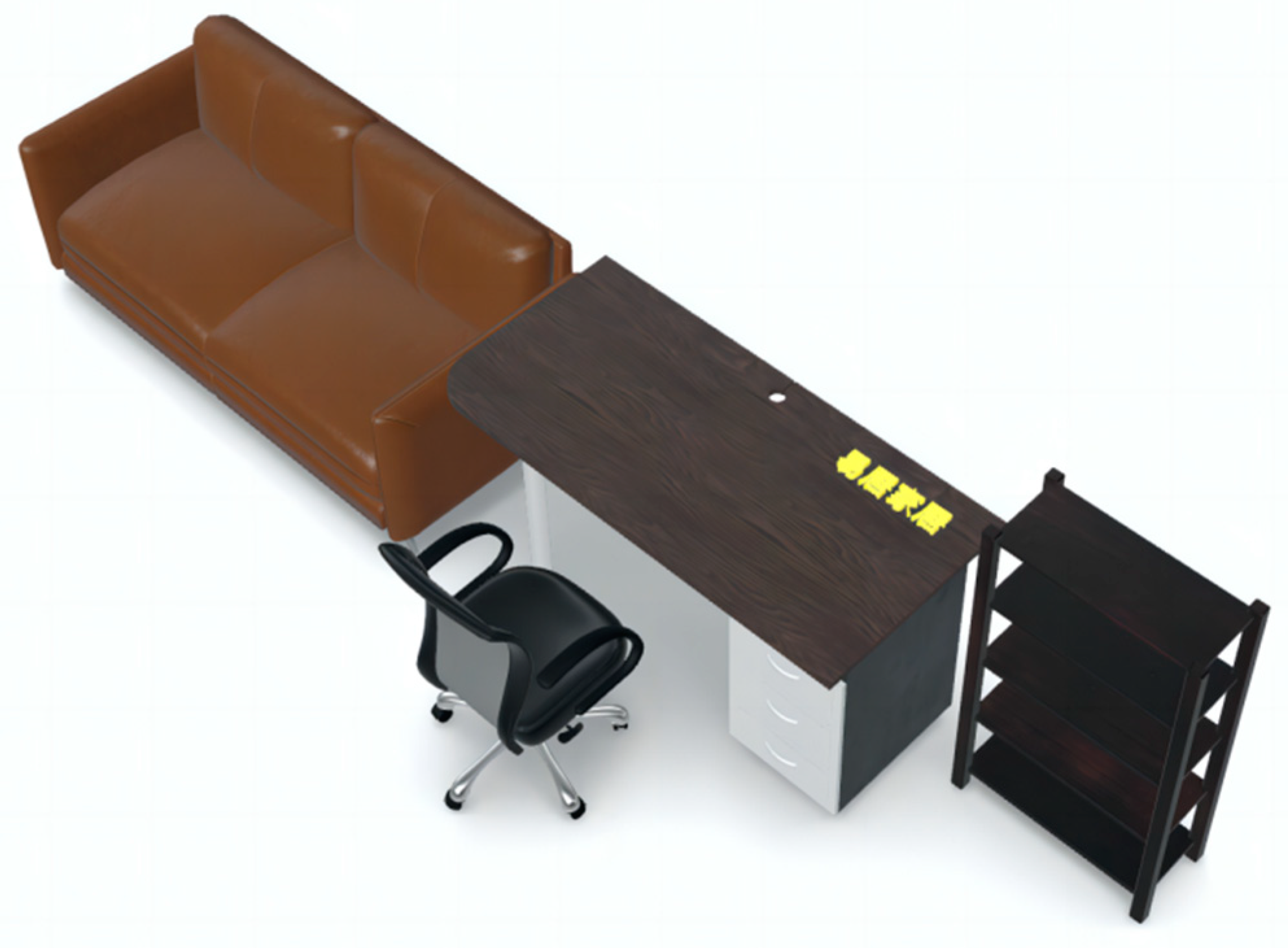
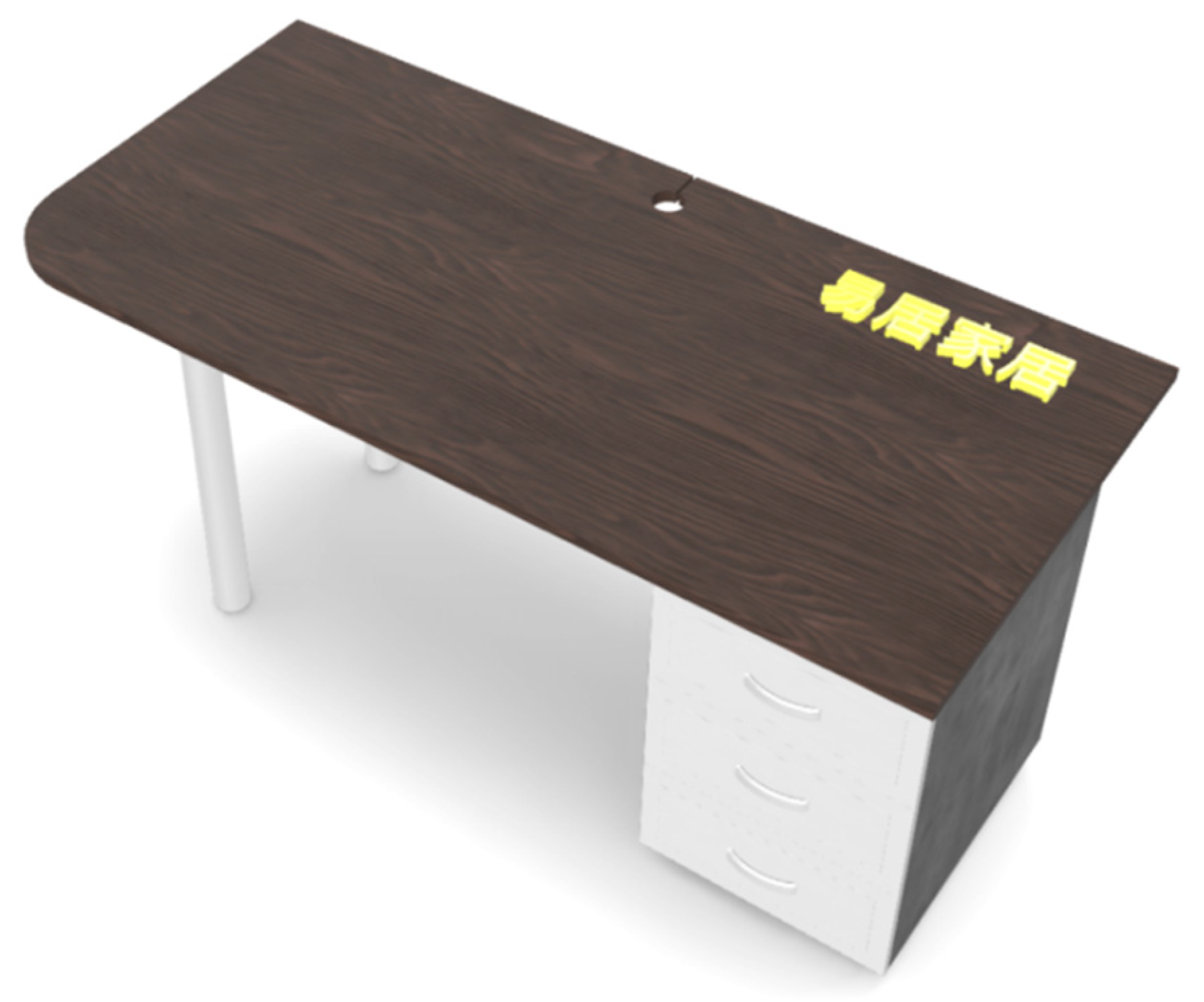


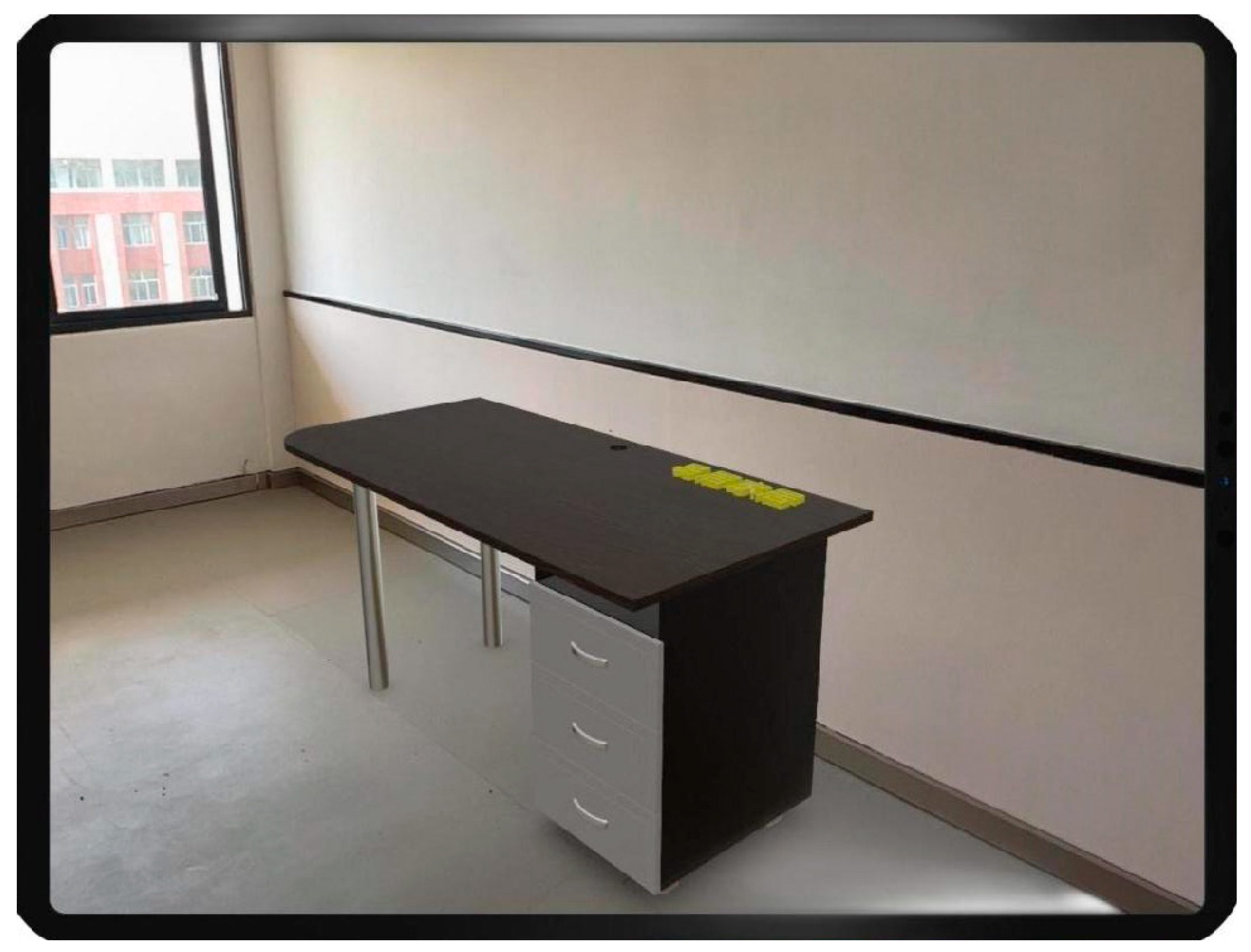
References
- Hee Lee, J.; Shvetsova, O.A. The impact of VR application on student’s competency development: A comparative study of regular and VR engineering classes with similar competency scopes. Sustainability 2019, 11, 2221. [Google Scholar] [CrossRef]
- Bacca-Acosta, J.; Avila-Garzon, C.; Sierra-Puentes, M. Insights into the Predictors of Empathy in Virtual Reality Environments. Information 2023, 14, 465. [Google Scholar] [CrossRef]
- de Ruyter, K.; Heller, J.; Hilken, T.; Chylinski, M.; Keeling, D.I.; Mahr, D. Seeing with the customer’s eye: Exploring the challenges and opportunities of AR advertising. J. Advert. 2020, 49, 109–124. [Google Scholar] [CrossRef]
- von der Au, S.; Rauschnabel, P.A.; Felix, R.; Hinsch, C. Context in augmented reality marketing: Does the place of use matter? Psychol. Mark. 2023, 40, 2447–2463. [Google Scholar] [CrossRef]
- Flavián, C.; Ibáñez-Sánchez, S.; Orús, C. The impact of virtual, augmented and mixed reality technologies on the customer experience. J. Bus. Res. 2019, 100, 547–560. [Google Scholar] [CrossRef]
- Javornik, A.; Marder, B.; Pizzetti, M.; Warlop, L. Augmented self-The effects of virtual face augmentation on consumers’ self-concept. J. Bus. Res. 2021, 130, 170–187. [Google Scholar] [CrossRef]
- Jessen, A.; Hilken, T.; Chylinski, M.; Mahr, D.; Heller, J.; Keeling, D.I.; de Ruyter, K. The playground effect: How augmented reality drives creative customer engagement. J. Bus. Res. 2020, 116, 85–98. [Google Scholar] [CrossRef]
- Kumar, H.; Rauschnabel, P.A.; Agarwal, M.N.; Singh, R.K.; Srivastava, R. Towards a theoretical framework for augmented reality marketing: A means-end chain perspective on retailing. Inf. Manag. 2024, 61, 103910. [Google Scholar] [CrossRef]
- Heller, J.; Chylinski, M.; de Ruyter, K.; Mahr, D.; Keeling, D.I. Touching the untouchable: Exploring multi-sensory augmented reality in the context of online retailing. J. Retail. 2019, 95, 219–234. [Google Scholar] [CrossRef]
- Wedel, M.; Bigné, E.; Zhang, J. Virtual and augmented reality: Advancing research in consumer marketing. Int. J. Res. Mark. 2020, 37, 443–465. [Google Scholar] [CrossRef]
- Tan, Y.C.; Chandukala, S.R.; Reddy, S.K. Augmented reality in retail and its impact on sales. J. Mark. 2022, 86, 48–66. [Google Scholar] [CrossRef]
- Rauschnabel, P.A.; Babin, B.J.; tom Dieck, M.C.; Krey, N.; Jung, T. What is augmented reality marketing? Its definition, complexity, and future. J. Bus. Res. 2022, 142, 1140–1150. [Google Scholar] [CrossRef]
- Kabadayi, E.T.; Alan, A. Brand trust and brand affect: Their strategic importance on brand loyalty. J. Glob. Strateg. Manag. 2012, 11, 81–88. [Google Scholar] [CrossRef]
- Fuller, R.; Stocchi, L.; Gruber, T.; Romaniuk, J. Advancing the understanding of the pre-purchase stage of the customer journey for service brands. Eur. J. Mark. 2023, 57, 360–386. [Google Scholar] [CrossRef]
- Keller, K.L. Conceptualizing, measuring, and managing customer-based brand equity. J. Mark. 1993, 57, 1–22. [Google Scholar] [CrossRef]
- Park, J.; Lee, H. Relationship between Brand Experience, Local Presence, Flow, and Brand Attitude While Applying Spatial Augmented Reality to a Brand Store. Int. J. Hum. –Comput. Interact. 2023, 1–14. [Google Scholar] [CrossRef]
- Hilken, T.; De Ruyter, K.; Chylinski, M.; Mahr, D.; Keeling, D.I. Augmenting the eye of the beholder: Exploring the strategic potential of augmented reality to enhance online service experiences. J. Acad. Mark. Sci. 2017, 45, 884–905. [Google Scholar] [CrossRef]
- Barsalou, L.W. Perceptual symbol systems. Behav. Brain Sci. 1999, 22, 577–660. [Google Scholar] [CrossRef]
- Niedenthal, P.M.; Barsalou, L.W.; Winkielman, P.; Krauth-Gruber, S.; Ric, F. Embodiment in attitudes, social perception, and emotion. Personal. Soc. Psychol. Rev. 2005, 9, 184–211. [Google Scholar] [CrossRef]
- Lavoye, V.; Tarkiainen, A.; Sipilä, J.; Mero, J. More than skin-deep: The influence of presence dimensions on purchase intentions in augmented reality shopping. J. Bus. Res. 2023, 169, 114247. [Google Scholar] [CrossRef]
- Hilken, T.; Heller, J.; Keeling, D.I.; Chylinski, M.; Mahr, D.; de Ruyter, K. Bridging imagination gaps on the path to purchase with augmented reality: Field and experimental evidence. J. Interact. Mark. 2022, 57, 356–375. [Google Scholar] [CrossRef]
- Ma, Y.; Cao, Y.; Li, L.; Zhang, J.; Clement, A.P. Following the flow: Exploring the impact of mobile technology environment on user’s virtual experience and behavioral response. J. Theor. Appl. Electron. Commer. Res. 2021, 16, 170–187. [Google Scholar] [CrossRef]
- Yoo, J.; Kim, J.H.; Kim, M.; Park, M. Imagery evoking visual and verbal information presentations in mobile commerce: The roles of augmented reality and product review. J. Res. Interact. Mark. 2023, 18, 182–197. [Google Scholar] [CrossRef]
- Luangrath, A.W.; Peck, J.; Hedgcock, W.; Xu, Y. Observing product touch: The vicarious haptic effect in digital marketing and virtual reality. J. Mark. Res. 2022, 59, 306–326. [Google Scholar] [CrossRef]
- Hilken, T.; Keeling, D.I.; de Ruyter, K.; Mahr, D.; Chylinski, M. Seeing eye to eye: Social augmented reality and shared decision making in the marketplace. J. Acad. Mark. Sci. 2020, 48, 143–164. [Google Scholar] [CrossRef]
- Han, X.; Wang, F.; Lv, S.; Han, W. Mechanism linking AR-based presentation mode and consumers’ responses: A moderated serial mediation model. J. Theor. Appl. Electron. Commer. Res. 2021, 16, 2694–2707. [Google Scholar] [CrossRef]
- Heller, J.; Chylinski, M.; de Ruyter, K.; Mahr, D.; Keeling, D.I. Let me imagine that for you: Transforming the retail frontline through augmenting customer mental imagery ability. J. Retail. 2019, 95, 94–114. [Google Scholar] [CrossRef]
- Hargrove, A.; Sommer, J.M.; Jones, J.J. Virtual reality and embodied experience induce similar levels of empathy change: Experimental evidence. Comput. Hum. Behav. Rep. 2020, 2, 100038. [Google Scholar] [CrossRef]
- Rauschnabel, P.A.; Felix, R.; Hinsch, C. Augmented reality marketing: How mobile AR-apps can improve brands through inspiration. J. Retail. Consum. Serv. 2019, 49, 43–53. [Google Scholar] [CrossRef]
- de Amorim, I.P.; Guerreiro, J.; Eloy, S.; Loureiro, S.M.C. How augmented reality media richness influences consumer behaviour. Int. J. Consum. Stud. 2022, 46, 2351–2366. [Google Scholar] [CrossRef]
- Hoffmann, S.; Joerß, T.; Mai, R.; Akbar, P. Augmented reality-delivered product information at the point of sale: When information controllability backfires. J. Acad. Mark. Sci. 2022, 50, 743–776. [Google Scholar] [CrossRef] [PubMed]
- Zanger, V.; Meißner, M.; Rauschnabel, P.A. Beyond the gimmick: How affective responses drive brand attitudes and intentions in augmented reality marketing. Psychol. Mark. 2022, 39, 1285–1301. [Google Scholar] [CrossRef]
- Baek, T.H.; Yoo, C.Y.; Yoon, S. Augment yourself through virtual mirror: The impact of self-viewing and narcissism on consumer responses. Int. J. Advert. 2018, 37, 421–439. [Google Scholar] [CrossRef]
- Scholz, J.; Duffy, K. We ARe at home: How augmented reality reshapes mobile marketing and consumer-brand relationships. J. Retail. Consum. Serv. 2018, 44, 11–23. [Google Scholar] [CrossRef]
- Siddiqui, M.S.; Siddiqui, U.A.; Khan, M.A.; Alkandi, I.G.; Saxena, A.K.; Siddiqui, J.H. Creating electronic word of mouth credibility through social networking sites and determining its impact on brand image and online purchase intentions in India. J. Theor. Appl. Electron. Commer. Res. 2021, 16, 1008–1024. [Google Scholar] [CrossRef]
- Baumann, C.; Hamin, H.; Chong, A. The role of brand exposure and experience on brand recall—Product durables vis-à-vis FMCG. J. Retail. Consum. Serv. 2015, 23, 21–31. [Google Scholar] [CrossRef]
- Nedungadi, P. Recall and consumer consideration sets: Influencing choice without altering brand evaluations. J. Consum. Res. 1990, 17, 263–276. [Google Scholar] [CrossRef]
- Chaney, I.; Hosany, S.; Wu MS, S.; Chen CH, S.; Nguyen, B. Size does matter: Effects of in-game advertising stimuli on brand recall and brand recognition. Comput. Hum. Behav. 2018, 86, 311–318. [Google Scholar] [CrossRef]
- Vashisht, D.; Royne, M.B. Advergame speed influence and brand recall: The moderating effects of brand placement strength and gamers’ persuasion knowledge. Comput. Hum. Behav. 2016, 63, 162–169. [Google Scholar] [CrossRef]
- Baack, D.W.; Wilson, R.T.; Till, B.D. Creativity and memory effects: Recall, recognition, and an exploration of nontraditional media. J. Advert. 2008, 37, 85–94. [Google Scholar] [CrossRef]
- Davtyan, D.; Stewart, K.; Cunningham, I. Comparing brand placements and advertisements on brand recall and recognition. J. Advert. Res. 2016, 56, 299–310. [Google Scholar] [CrossRef]
- Vashist, D. Effect of product involvement and brand prominence on advergamers’ brand recall and brand attitude in an emerging market context. Asia Pac. J. Mark. Logist. 2018, 30, 43–61. [Google Scholar] [CrossRef]
- Myers, S.D.; Deitz, G.D.; Huhmann, B.A.; Jha, S.; Tatara, J.H. An eye-tracking study of attention to brand-identifying content and recall of taboo advertising. J. Bus. Res. 2020, 111, 176–186. [Google Scholar] [CrossRef]
- Garbarini, F.; Adenzato, M. At the root of embodied cognition: Cognitive science meets neurophysiology. Brain Cogn. 2004, 56, 100–106. [Google Scholar] [CrossRef] [PubMed]
- Krishna, A.; Schwarz, N. Sensory marketing, embodiment, and grounded cognition: A review and introduction. J. Consum. Psychol. 2014, 24, 159–168. [Google Scholar] [CrossRef]
- Niedenthal, P.M.; Winkielman, P.; Mondillon, L.; Vermeulen, N. Embodiment of emotion concepts. J. Personal. Soc. Psychol. 2009, 96, 1120. [Google Scholar] [CrossRef]
- Lee SH, M.; Rotman, J.D.; Perkins, A.W. Embodied cognition and social consumption: Self-regulating temperature through social products and behaviors. J. Consum. Psychol. 2014, 24, 234–240. [Google Scholar]
- Krishna, A.; Lee, S.W.; Li, X.; Schwarz, N. Embodied cognition, sensory marketing, and the conceptualization of consumers’ judgment and decision processes: Introduction to the issue. J. Assoc. Consum. Res. 2017, 2, 377–381. [Google Scholar] [CrossRef]
- Eelen, J.; Dewitte, S.; Warlop, L. Situated embodied cognition: Monitoring orientation cues affects product evaluation and choice. J. Consum. Psychol. 2013, 23, 424–433. [Google Scholar] [CrossRef]
- Van Rompay, T.J.; De Vries, P.W.; Bontekoe, F.; Tanja-Dijkstra, K. Embodied product perception: Effects of verticality cues in advertising and packaging design on consumer impressions and price expectations. Psychol. Mark. 2012, 29, 919–928. [Google Scholar] [CrossRef]
- Hong, J.; Sun, Y. Warm it up with love: The effect of physical coldness on liking of romance movies. J. Consum. Res. 2012, 39, 293–306. [Google Scholar] [CrossRef]
- Van Kerckhove, A.; Geuens, M.; Vermeir, I. The floor is nearer than the sky: How looking up or down affects construal level. J. Consum. Res. 2015, 41, 1358–1371. [Google Scholar] [CrossRef]
- Peck, J.; Childers, T.L. To have and to hold: The influence of haptic information on product judgments. J. Mark. 2003, 67, 35–48. [Google Scholar] [CrossRef]
- Peck, J.; Wiggins, J. It just feels good: Customers’ affective response to touch and its influence on persuasion. J. Mark. 2006, 70, 56–69. [Google Scholar]
- Krishna, A.; Lwin, M.O.; Morrin, M. Product scent and memory. J. Consum. Res. 2010, 37, 57–67. [Google Scholar] [CrossRef]
- Krishna, A. An integrative review of sensory marketing: Engaging the senses to affect perception, judgment and behavior. J. Consum. Psychol. 2012, 22, 332–351. [Google Scholar] [CrossRef]
- Ardelet, C. Mobile advertising: The effect of tablet tilt angle on user’s purchase intentions. J. Mark. Commun. 2020, 26, 166–185. [Google Scholar] [CrossRef]
- Petit, O.; Velasco, C.; Spence, C. Digital sensory marketing: Integrating new technologies into multisensory online experience. J. Interact. Mark. 2019, 45, 42–61. [Google Scholar] [CrossRef]
- Elder, R.S.; Krishna, A. The “visual depiction effect” in advertising: Facilitating embodied mental simulation through product orientation. J. Consum. Res. 2012, 38, 988–1003. [Google Scholar] [CrossRef]
- Wilson, M. Six views of embodied cognition. Psychon. Bull. Rev. 2002, 9, 625–636. [Google Scholar] [CrossRef]
- DeSutter, D.; Stieff, M. Teaching students to think spatially through embodied actions: Design principles for learning environments in science, technology, engineering, and mathematics. Cogn. Res. Princ. Implic. 2017, 2, 22. [Google Scholar] [CrossRef] [PubMed]
- Sinnamon, C.; Miller, E. Architectural concept design process impacted by body and movement. Int. J. Technol. Des. Educ. 2022, 32, 1079–1102. [Google Scholar] [CrossRef]
- Kiefer, M.; Trumpp, N.M. Embodiment theory and education: The foundations of cognition in perception and action. Trends Neurosci. Educ. 2012, 1, 15–20. [Google Scholar] [CrossRef]
- Spackman, J.S.; Yanchar, S.C. Embodied cognition, representationalism, and mechanism: A review and analysis. J. Theory Soc. Behav. 2014, 44, 46–79. [Google Scholar] [CrossRef]
- Castro-Alonso, J.C.; Paas, F.; Ginns, P. Embodied cognition, science education, and visuospatial processing. In Visuospatial Processing for Education in Health and Natural Sciences; Springer: Cham, Switzerland, 2019; pp. 175–205. [Google Scholar]
- Celsi, R.L.; Olson, J.C. The role of involvement in attention and comprehension processes. J. Consum. Res. 1988, 15, 210–224. [Google Scholar] [CrossRef]
- Behe, B.K.; Bae, M.; Huddleston, P.T.; Sage, L. The effect of involvement on visual attention and product choice. J. Retail. Consum. Serv. 2015, 24, 10–21. [Google Scholar] [CrossRef]
- Ianì, F. Embodied memories: Reviewing the role of the body in memory processes. Psychon. Bull. Rev. 2019, 26, 1747–1766. [Google Scholar] [CrossRef]
- Sullivan, J.V. Learning and embodied cognition: A review and proposal. Psychol. Learn. Teach. 2018, 17, 128–143. [Google Scholar] [CrossRef]
- Carrozzi, A.; Chylinski, M.; Heller, J.; Hilken, T.; Keeling, D.I.; de Ruyter, K. What’s mine is a hologram? How shared augmented reality augments psychological ownership. J. Interact. Mark. 2019, 48, 71–88. [Google Scholar] [CrossRef]
- Hong, W.; Thong, J.Y.; Tam, K.Y. The effects of information format and shopping task on consumers’ online shopping behavior: A cognitive fit perspective. J. Manag. Inf. Syst. 2004, 21, 149–184. [Google Scholar] [CrossRef]
- Rixom, J.M.; Mas, E.M.; Rixom, B.A. Presentation matters: The effect of wrapping neatness on gift attitudes. J. Consum. Psychol. 2020, 30, 329–338. [Google Scholar] [CrossRef]
- Zhao, M.; Xia, L. Joint or separate? The effect of visual presentation on imagery and product evaluation. Int. J. Res. Mark. 2021, 38, 935–952. [Google Scholar] [CrossRef]
- Derdenger, T.; Kumar, V. The dynamic effects of bundling as a product strategy. Mark. Sci. 2013, 32, 827–859. [Google Scholar] [CrossRef]
- Li, N.; Song, J.D. Impact of mixed bundling type on consumers’ value perception. Int. J. Consum. Stud. 2022, 46, 2167–2182. [Google Scholar] [CrossRef]
- Liu, H.H.; Chou, H.Y. The effects of promotional frames of sales packages on perceived price increases and repurchase intentions. Int. J. Res. Mark. 2015, 32, 23–33. [Google Scholar] [CrossRef]
- Van Osselaer, S.M.; Janiszewski, C. Two ways of learning brand associations. J. Consum. Res. 2001, 28, 202–223. [Google Scholar] [CrossRef]
- Henderson, G.R.; Iacobucci, D.; Calder, B.J. Brand diagnostics: Mapping branding effects using consumer associative networks. Eur. J. Oper. Res. 1998, 111, 306–327. [Google Scholar] [CrossRef]
- Ajanki, A.; Billinghurst, M.; Gamper, H.; Järvenpää, T.; Kandemir, M.; Kaski, S.; Koskela, M.; Kurimo, M.; Laaksonen, J.; Puolamäki, K.; et al. An augmented reality interface to contextual information. Virtual Real. 2011, 15, 161–173. [Google Scholar] [CrossRef]
- Anderson, J.R. A spreading activation theory of memory. J. Verbal Learn. Verbal Behav. 1983, 22, 261–295. [Google Scholar] [CrossRef]
- Zhang, M.; Li, Y.; Li, Y.; Ren, X. Beyond presence: Creating attractive online retailing stores through the cool AR technology. Int. J. Consum. Stud. 2023, 47, 1139–1156. [Google Scholar] [CrossRef]
- tom Dieck, M.C.; Cranmer, E.; Prim, A.L.; Bamford, D. The effects of augmented reality shopping experiences: Immersion, presence and satisfaction. J. Res. Interact. Mark. 2023, 17, 940–958. [Google Scholar] [CrossRef]
- Jin, H.S.; Kerr, G.; Suh, J. Impairment effects of creative ads on brand recall for other ads. Eur. J. Mark. 2019, 53, 1466–1483. [Google Scholar] [CrossRef]
- Alba, J.W.; Chattopadhyay, A. Salience effects in brand recall. J. Mark. Res. 1986, 23, 363–369. [Google Scholar] [CrossRef]
- Kuisma, J.; Simola, J.; Uusitalo, L.; Öörni, A. The effects of animation and format on the perception and memory of online advertising. J. Interact. Mark. 2010, 24, 269–282. [Google Scholar] [CrossRef]
- Kujur, F.; Singh, S. Visual communication and consumer-brand relationship on social networking sites-uses & gratifications theory perspective. J. Theor. Appl. Electron. Commer. Res. 2020, 15, 30–47. [Google Scholar] [CrossRef]
- Hilken, T.; Chylinski, M.; Keeling, D.I.; Heller, J.; de Ruyter, K.; Mahr, D. How to strategically choose or combine augmented and virtual reality for improved online experiential retailing. Psychol. Mark. 2022, 39, 495–507. [Google Scholar] [CrossRef]
- Pfaff, A.; Spann, M. When reality backfires: Product evaluation context and the effectiveness of augmented reality in e-commerce. Psychol. Mark. 2023, 40, 2413–2427. [Google Scholar] [CrossRef]
- Janiszewski, C.; Kuo, A.; Tavassoli, N.T. The influence of selective attention and inattention to products on subsequent choice. J. Consum. Res. 2013, 39, 1258–1274. [Google Scholar] [CrossRef]
- Yim MY, C.; Chu, S.C.; Sauer, P.L. Is augmented reality technology an effective tool for e-commerce? An interactivity and vividness perspective. J. Interact. Mark. 2017, 39, 89–103. [Google Scholar] [CrossRef]
- Smink, A.R.; Van Reijmersdal, E.A.; Van Noort, G.; Neijens, P.C. Shopping in augmented reality: The effects of spatial presence, personalization and intrusiveness on app and brand responses. J. Bus. Res. 2020, 118, 474–485. [Google Scholar] [CrossRef]
- McLean, G.; Wilson, A. Shopping in the digital world: Examining customer engagement through augmented reality mobile applications. Comput. Hum. Behav. 2019, 101, 210–224. [Google Scholar] [CrossRef]
- Kang, H.J.; Shin, J.H.; Ponto, K. How 3D virtual reality stores can shape consumer purchase decisions: The roles of informativeness and playfulness. J. Interact. Mark. 2020, 49, 70–85. [Google Scholar] [CrossRef]
- He, X.; Liu, Q.; Jung, S. The impact of recommendation system on user satisfaction: A moderated mediation approach. J. Theor. Appl. Electron. Commer. Res. 2024, 19, 448–466. [Google Scholar] [CrossRef]
- Senecal, S.; Nantel, J. The influence of online product recommendations on consumers’ online choices. J. Retail. 2004, 80, 159–169. [Google Scholar] [CrossRef]
- Li, J.; Abbasi, A.; Cheema, A.; Abraham, L.B. Path to purpose? How online customer journeys differ for hedonic versus utilitarian purchases. J. Mark. 2020, 84, 127–146. [Google Scholar] [CrossRef]
- Gao, H. The Impact of Topological Structure, Product Category, and Online Reviews on Co-Purchase: A Network Perspective. J. Theor. Appl. Electron. Commer. Res. 2023, 18, 548–570. [Google Scholar] [CrossRef]

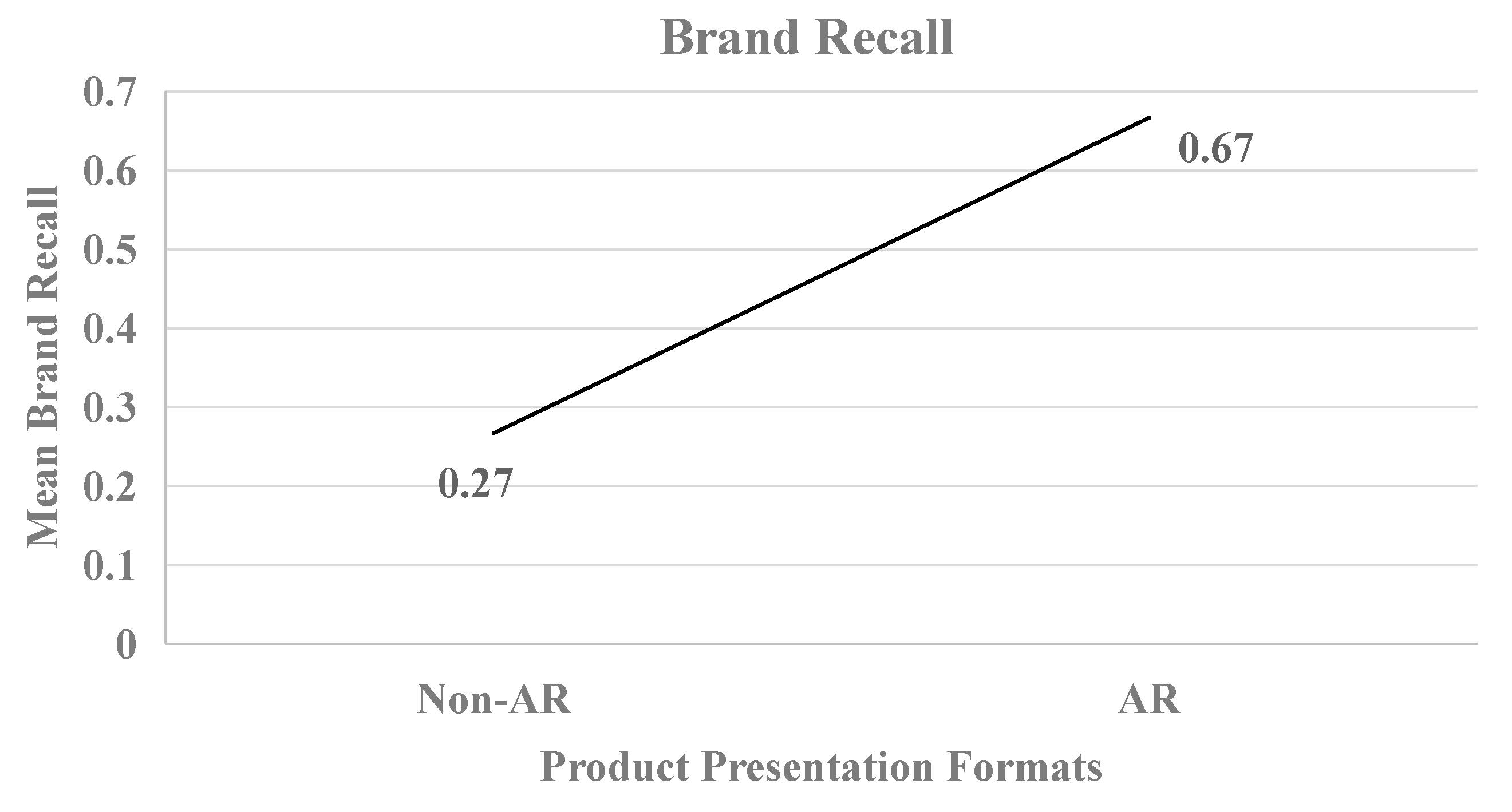
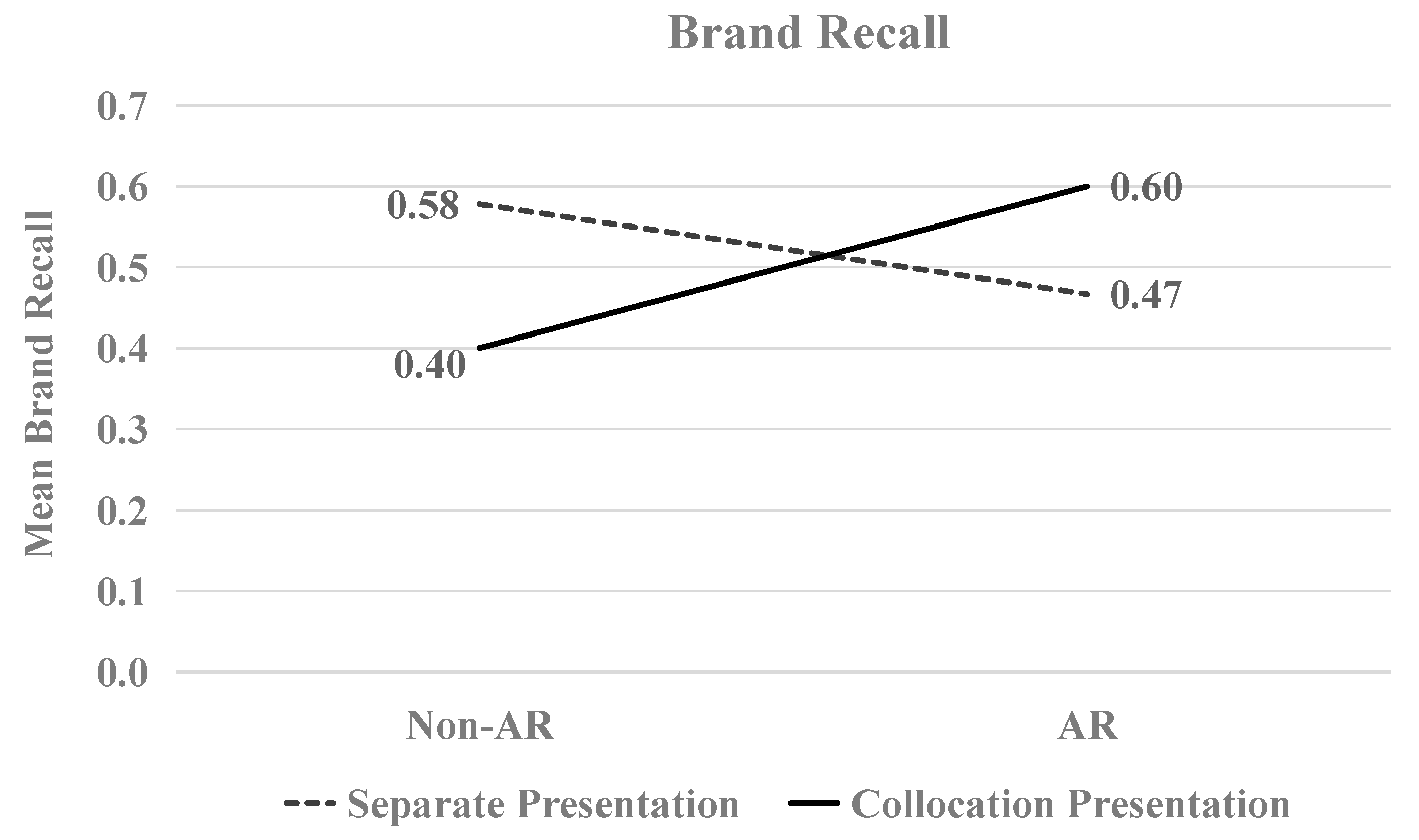
| Demographic Characteristics | Number of Participants | Percentage Rates | |
|---|---|---|---|
| Gerder | Male | 10 | 16.7% |
| Female | 50 | 83.3% | |
| Age | 18–21 | 46 | 76.7% |
| 22–25 | 13 | 21.7% | |
| 26–45 | 1 | 1.6% | |
| Education | College and university | 53 | 88.3% |
| Graduate school and above | 7 | 11.7% |
| Demographic Characteristics | Number of Participants | Percentage Rates | |
|---|---|---|---|
| Gerder | Male | 25 | 13.9% |
| Female | 155 | 86.1% | |
| Age | 18–21 | 102 | 56.7% |
| 22–25 | 74 | 41.1% | |
| 26–45 | 4 | 2.2% | |
| Education | College and university | 140 | 77.8% |
| Graduate school and above | 40 | 22.2% |
Disclaimer/Publisher’s Note: The statements, opinions and data contained in all publications are solely those of the individual author(s) and contributor(s) and not of MDPI and/or the editor(s). MDPI and/or the editor(s) disclaim responsibility for any injury to people or property resulting from any ideas, methods, instructions or products referred to in the content. |
© 2024 by the authors. Licensee MDPI, Basel, Switzerland. This article is an open access article distributed under the terms and conditions of the Creative Commons Attribution (CC BY) license (https://creativecommons.org/licenses/by/4.0/).
Share and Cite
Zhou, L.; Niu, L.; Zhao, T. The Differential Effects of Augmented Reality and Product Presentation Strategies on Brand Recall: An Embodied Cognition Perspective. J. Theor. Appl. Electron. Commer. Res. 2024, 19, 3035-3050. https://doi.org/10.3390/jtaer19040146
Zhou L, Niu L, Zhao T. The Differential Effects of Augmented Reality and Product Presentation Strategies on Brand Recall: An Embodied Cognition Perspective. Journal of Theoretical and Applied Electronic Commerce Research. 2024; 19(4):3035-3050. https://doi.org/10.3390/jtaer19040146
Chicago/Turabian StyleZhou, Liying, Limin Niu, and Taiyang Zhao. 2024. "The Differential Effects of Augmented Reality and Product Presentation Strategies on Brand Recall: An Embodied Cognition Perspective" Journal of Theoretical and Applied Electronic Commerce Research 19, no. 4: 3035-3050. https://doi.org/10.3390/jtaer19040146
APA StyleZhou, L., Niu, L., & Zhao, T. (2024). The Differential Effects of Augmented Reality and Product Presentation Strategies on Brand Recall: An Embodied Cognition Perspective. Journal of Theoretical and Applied Electronic Commerce Research, 19(4), 3035-3050. https://doi.org/10.3390/jtaer19040146






